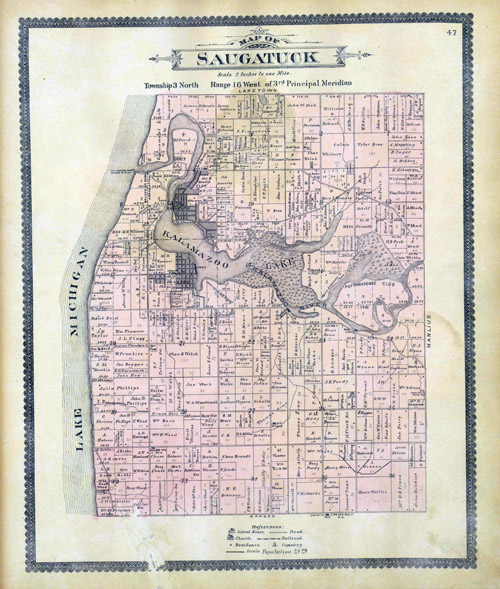
[Saugatuck township], which was the earliest one settled in Allegan County, was surveyed as township 3 north, range 16 west. It is bounded on the north by Laketown, south by Ganges, east by Manlius, and west by the waters of Lake Michigan.
It contains two incorporated villages, Saugatuck and Douglas,
situated on either side of Kalamazoo Lake, three miles by the course of
the stream from the mouth of the river of that name, but less than a
mile from the lake-shore. These villages are important shipping-points
for lumber and fruit, and, although without immediate railway
facilities, have easy water communication with all important lake points
by steamers and sailing-vessels throughout the season of navigation. A
regular line of steamers, owned and managed by Captain R. C. Brittain,
plies between the two villages mentioned and Chicago. The lumber
business, which has been very important, is now declining, but the loss
on that account has been made good by the rapid development of
fruit-culture. The peach-producing qualities of Western Allegan are
remarkably conspicuous, even in so celebrated a fruit bearing State as
Michigan, and that section is likely to improve materially in value for
an indefinite time to come. Although general farming is carried on to
some extent, the cultivation of fruit especially peaches is the great
feature in rural industry throughout the township of Saugatuck.
The Kalamazoo River
is navigable for large craft to the two villages named, where it
expands into a lake, and is also navigable to Richmond for light draught
steamers, although latterly not much used for that purpose. The
township sought, in 1869, by an offered donation of $40,000, to bring
the Chicago and West Michigan Railroad within its borders, but other influences prevailed, and close railway communication is still a much-desired privilege.
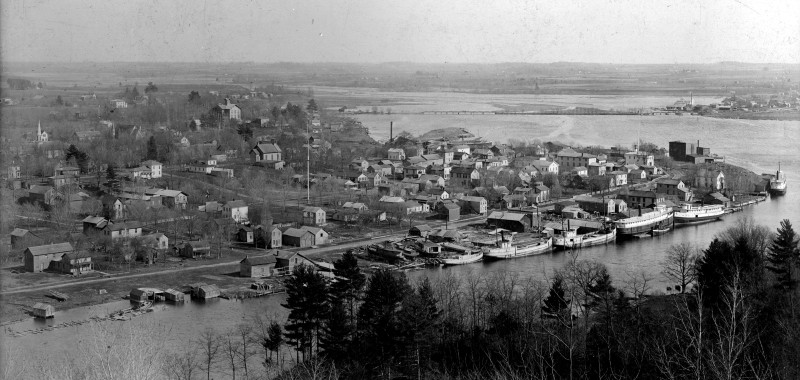
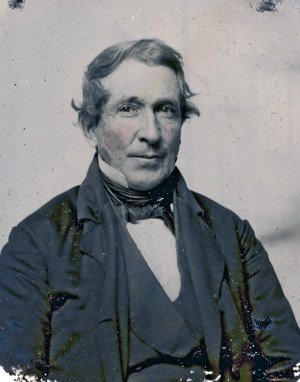
William G. Butler,
of Hartford, Conn., came to the site of Saugatuck village as the first
white settler, in the spring of 1830.* Mr. Butler had pre-empted the
tract now occupied by the village, and brought his wife and two children
with him by way of the lakes, a vessel landing him with his family and
household effects at the mouth of the river. He speedily erected a log
cabin on a spot now in the middle of the street in front of the Saugatuck House**,
and began at once the business of trading with the Indians, who swarmed
in great numbers in that region, and were always ready to barter game,
furs, and sugar for the white man's goods. Butler had brought but few
goods with him, but had some whisky, which latter suited the red man
better than anything else, and the demand for it was unfailing.
*There was then no other permanent white resident of Allegan County; the
township of Otsego not being settled until the ensuing autumn.
**The Saugatuck House was a hotel located on the northeast corner of
Butler and Mason streets in Saugatuck, the location of the present
Parrish Drug store building, built in 1913. The Lake Shore Commercial
of 27 May 1892 in reference to Willam G. Butler's cabin states: the
exact location being that now occupied by the Roda Building. This would
place it on the northwest corner of Butler and Mason streets in downtown
Saugatuck.
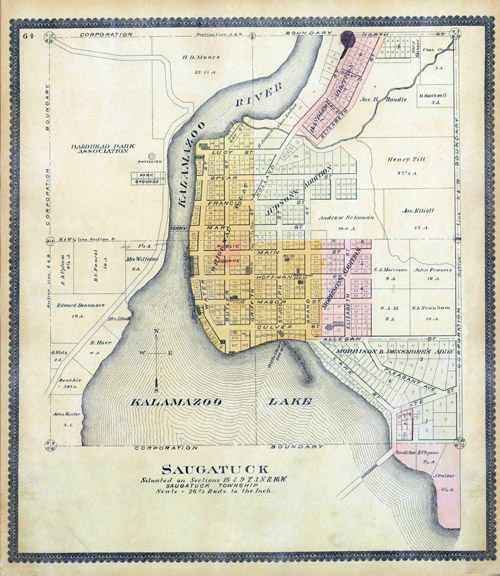
We may designate Mr. Butler as the first permanent resident of the
county. There were already some French traders with the Indians within
the county limits, but these did not locate with a view to permanent
residence, and are therefore not counted as settlers. Mr. Butler, on the
other hand, although for Several years he did nothing but trade with
the Indians, had purchased land with the intention of remaining after
the Indians had gone as he did. It was doubtless the presence of a
natural harbor that led Mr. Butler to locate where he did, for it
appears that he counted from the first upon founding a village there. It
is also likely that the abundance of hemlock bark and ship timber near
at hand strengthened his hopes touching the ultimate importance of the
place. However that may have been, it is certain that the capitalists
who came a few years later were attracted by the opportunities for
lumbering and tanning which existed in the vicinity, and which were
promptly improved, those occupations having for nearly fifty years been
important factors in promoting the prosperity of the Saugatuck country.
Mr. Butler's business with the Indians frequently took him away from
home, and sometimes he was obliged to be absent several days, his wife
meanwhile remaining alone with her children in their log cabin, a
voluntary exile from her race, her only neighbors Indians, and her only
surroundings the forest. For three years the Butlers lived by the side
of the river, the only white inhabitants in the western part of the
county, and during that time Mrs. Butler saw no woman's face save the
dusky countenances of Indian squaws, who visited her frequently, and
with whom, as well as with the braves, she was on the most kindly terms
of friendship.
Although Mr. Butler succeeded well enough in his trade with the Indians
and experienced no extraordinary hardships, he was always greatly
troubled when brought face to face with the stern necessity of going to
mill. During the first part of his sojourn at Saugatuck he was obliged
to go to Elkhart, Ind., seventy-five miles distant, for that pur. pose,
and the long, tedious, and difiicult journey was always looked forward
to with great dislike.
Until the year 1834 the Butler family continued to be the only white
inhabitants of this section, but early in that year there came Edward
Johonnett and R. R. Crosby**, who built in company a tannery on the river, near where Williams & Grifiin's saw-mill now stands. Daniel Plummer,
a carpenter, also came about the same time, and put up a framed house
on Hoffman Street, the same building being now occupied as a residence
by Henry Holt.
Mr. Plummer remained in town until 1849, when he took the California
fever and migrated to the far West. Mr. Johonnett lived in a framed
house on the spot now occupied by the Odd-Fellows' building***, and Crosby (who was a bachelor) lived with him.
**Rensselaer R. Crosby's wife was Louisa (Johonnett) Crosby.
***The Odd-fellows' building is located on the Southwest corner of
Butler and Mason streets. On Sandborn fire insurance maps it would also
be the A. B. Taylor store, then the Russell Taylor "pay as you go"
store, then in 1901 for a short time E. L. Leland & Co's department
store, then Goshorn's.
In July, 1834, Stephen D. Nichols,
who had for a year been living in St. Joseph, Mich., came down the
lake-shore with H. F. Comstock**, landed at the mouth of the Kalamazoo,
and made a prospecting tour up the river. They found on the site of
Saugatuck Johonnett & Crosby's tannery, and the houses of the
Butlers, Plummers, and Johonnetts. Nichols concluded to take up 160
acres on section 17, and agreed with Comstock that the latter should put
up a warehouse for the former at the mouth of the river ; this course
being suggested by the fact that settlers bound for the up-river country
had begun to arrive, and there seemed a decided necessity for a
warehouse and pier, since there were no conveniences for the landing of
goods at the mouth of the river, and captains of vessels did not at that
time like to venture into the stream. Having determined upon a plan of
action, Nichols and Comstock engaged an Indian to take them up the lake
in a canoe to St. Joseph, whence Nichols proceeded with all speed to the
East. Nichols returned in September of the same year with his family,
and located permanently at the mouth of the Kalamazoo River, on the
north side. There he began straightway to erect a warehouse and dock.
There was no saw-mill in the vicinity, and for Nichols' warehouse, as
well as for the framed houses previously built by Plummer and Johonnett,
the lumber was brought down the river from Pine Creek, one mile below
Otsego.
**This appears to have been a misprint or error by the author, as no H.
F. Comstock is found in records from the area. Most likely this refers
to Gen. Horace Hawkin Comstock. Records at the BLM have Horace Comstock having patents at the mouth of the River and no other "H. Comstock" in Allegan county with land grants.
The warehouse was at first used principally for the storing of the
household effects of settlers moving by way of the lakes to the up-river
country, but ere long there sprang up a driving business in connection
with the reshipment of flour coming down the river to be forwarded
around the lakes. William G. Butler sought to share the business
controlled by Nichols, and early in 1835 built a warehouse on the
river-bank, two miles from the mouth, but the location was a poor one,
and the enterprise was substantially a failure. Meanwhile, Nichols
opened a store near his warehouse, and affairs in that vicinity took on
such a lively aspect that there was strong talk of starting a town
there, but the project never resulted in anything more definite in shape
than a plat on paper.
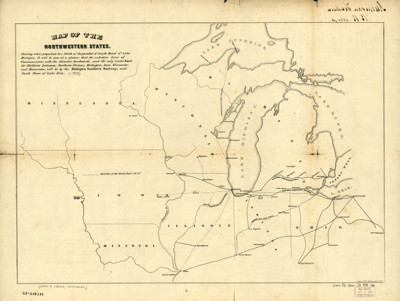
About 1842, Butler built a warehouse on the south side of the river,
opposite that of Nichols, and until 1846 both concerns carried on a
profitable business in shipping and receiving freight. In that year the
completion of the Michigan Central Railroad
to Kalamazoo greatly injured the river traffic, and in 1848, when that
road was finished to Niles, the forwarding business at the mouth of the
river came to an end, unless indeed we include the forwarding of rafts.
One of Saugatuck's pioneers, Benjamin Plummer,
now living in Ganges, relates how he came to the village with his wife
in the fall of 1834, and found residing there and at the mouth of the
river the families of William G. Butler, Stephen D. Nichols,
Johonnett & Crosby, the tanners, Daniel Plummer, and Palmer and
Mayo, the latter being two fishermen and Indian-traders living at the
river's mouth. Benjamin Plummer, like his brother Daniel, was a
carpenter, and after working at his trade two years started a saw-mill
northeast of the village, where he remained until 1846. He then
abandoned the mill and removed to his present home. Mr. and Mrs.
Plummer, who have shared the vicissitudes of pioneer life forty-six
years, have been man and wife no less than fifty-three years.
In 1844, A. S. Wells and O. R. Johnson
built a tannery near Plummer's saw-mill and carried it on until 1854,
when it passed into the possession of C. C. Wallin & Sons, the
present proprietors.
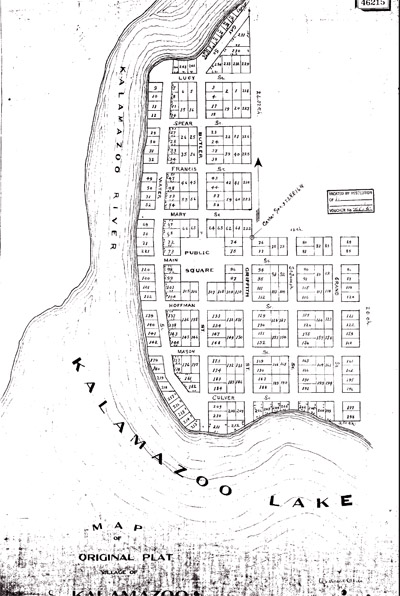
Previous to the coming of Nichols and the creation of the warehouse
traffic, Butler had, in 1833, platted a village upon his pre-empted
property, and called it Kalamazoo.
Soon afterwards Henry Hoffman,
of Niles, Jasper Mason, of St. Joseph, and John Griffith, of New York,
purchased an interest in the village property, of which, however, Butler
still retained a share.* A post-office was established at the village
in 1835, upon application of R. R. Crosby, who was commissioned
postmaster Aug. 4, 1835, the original commission being now in possession
of S. A. Morrison, Esq. At his suggestion the office was called
Saugatuck, an Indian word meaning " mouth of river." The village
retained the name of Kalamazoo until the incorporation of the village
now bearing that name. Being then deprived of it by the greater
celebrity of the latter place, it was called Newark, after the township
in which it was located. This appellation was retained until 1863, when
the name of both township and village was changed to Saugatuck. William
G. Butler, the founder of the town, continued to be one of its prominent
citizens until his death, in 1857, when he was killed while engaged in
log-rolling.
*The plat was recorded on the 17th of July, 1834, in the register's
office of Kalamazoo County, to which Allegan County was then attached.
The village is described on the record as laid out by J. Wittenmeier**,
surveyor, for William G. Butler, but it is evident that Mason and
Griffith had secured an interest, as two of the streets bore their
names.
**By a bio of Lewis Cass Wittenmyer (1828-1904), his father, John Wittenmeyer (1797-1848), the surveyor for William G. Butler, died in Aug 1848 (via a Rootsweb page, he died in Berrien County, Michigan).
In the month of May, 1837, Stephen A. Morrison
came from Vermont to Saugatuck for the purpose of starting a tannery,
having learned that the country thereabout was famous for hemlock-bark.
Upon reaching that place he found Johonnett & Crosby already engaged
in tanning, and so, instead of starting a fresh enterprise, he bought
out that firm. He carried on the business on the old site about five
years, when he removed the business to his present location, where he
has ever since been employed in the same occupation. Saugatuck village
improved slowly at first, and when Singapore reared its prosperous front
the former place was completely overshadowed, and could scarcely be
called more than a lumber-camp. In 1837 about the only business it
boasted was that of getting out ship-timber, and, although Stephen D.
Nichols had a small store at the mouth of the river and sold a few goods
from his house on Hoffman Street in the village, the inhabitants
usually traded at Singapore, for at the latter place only was there a
mercantile establishment of even moderate pretensions.
In 1836, Benjamin Plummer built a saw-mill
on the site of Wallin's tannery, on section 3, and in 1837 he and
Edward Johonnett operated it. During the next summer the business of
rafting lumber and square timber down the river to the lake set in in
earnest, and for some years continued to be an important industry.
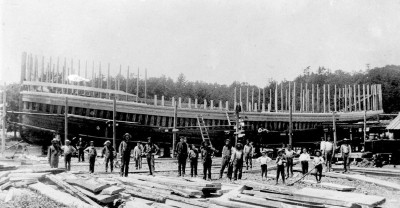
Ship-timber being abundant near Saugatuck, ship-builders came hither early, led by James McLaughlin**, who built at Saugatuck a lumber-vessel which he called the "Crook,"
Carter & Co., the successors of the Wilders at Singapore, built at
that point a lake-vessel for carrying lumber, and named it the "Octavia."
About that time other vessels were built at Saugatuck and Singapore,
and in 1842 Porter & Co. built at Singapore a flat-bottom steamboat,
named the "C. C. Trowbridge,"
and intended for the trade between Saugatuck and Allegan. That attempt
at steam navigation on the river was, however, a failure, and after a
few trips demonstrated it to be so the "Trowbridge" was transferred to other scenes.
**Via a bio for his son, Rev. James J. McLaughlin in Portrait and biographical record of northern Michigan, 1895,
James and Abigail (McDonald) McLaughlin were natives of Penobscot,
Maine. James was a carpenter by trade, and became a pioneer of Allegan,
Mich., in 1836. He built the first flouring-mill erected in that
village for Alexander L. Ely, formerly of Rochester, N. Y. In 1844 he
removed to the mouth of the Kalamazoo River, and sometime later opened a
ship-yard at Saugatuck. Here he constructed a number of vessels, and
bought and carried on a hotel at Kalamazoo besides. In 1848 he held a
position under the Government as a farmer among the Indians.
In the spring of 1849 he bought a vessel at Chicago, and, going to the
Grand Traverse region, cut the first stick of timber where Northport now
stands. In 1851 he removed with his family to Elk Rapids, and kept a
boardinghouse for A. S. Wadsworth, who, with his wife and S. K. Northam,
were the first white people to locate here. For a few years he engaged
in the manufacture of shingles, running a mill for that purpose, and
from 1858 to 1863 lived on a farm, where he died April 16, 1863 being
then in his seventy-fourth year.
His first wife, Abigail, was drowned in the Kalamazoo River, by the
capsizing of a boat, July 25, 1841. Their first son, Charles A., was the first white child born in Kalamazoo county. For his second wife, Mr. McLaughlin chose Lydia A. Case, who was born in Vermont, and who died in Elk Rapids Township in 1877.
A second attempt in the same direction, made with the "Adelaide," built
at Allegan, met with better results, and from that time forward until
1869 steamboats plied with
more or less regularity between Saugatuck and Allegan each season. First
and last, a large number of sailing-vessels and steamers have been
built at Saugatuck. Generally
the steamers have been tugs, although several lake-propellers and
lumber-barges have been constructed there, and several grain-carrying
vessels of the larger class have figured in the list. The year 1879 was
an especially busy one in ship building at Saugatuck**.
**The Great Lakes Maritime Database has 425 ships listed as being built
in Saugatuck, but only the Crook listed as being built in Singapore.
On the 17th of November, 1842, while the three-master "Milwaukie"**
was taking on a cargo off Saugatuck Harbor, a sudden squall of wind
drove it ashore, when the vessel was wrecked, and the captain and eight
of his men lost their lives. The victims were buried in the old Indian
burying-ground, then 'occupying the site now covered by the town-hall of
Saugatuck. Other casualties have occurred off the mouth of the river
from time to time, but none have reached the tragic importance that
attended the loss of the "Milwaukie."
**The name of the ship is often spelled "Milwaukee" in newspaper accounts of the day. The Great Lakes Maritime Database states the Milwaukie was built in 1836 at Grand Island, NY and was 113 feet long. In Pioneer Collections, Volume 3
it states: Nov 17 1842, the brig Milwaukee was lost off Saugatuck
harbor while being loaded, being driven ashore by a sudden squall of
wind, resulting in a total loss of her cargo (flour boated down from
Kalamazoo and owned by D. S. Walbridge). The captain and eight of his
crew all lost their lives. The weather was bitter cold when this
disaster occurred and was freezing very hard at the time.
Niles Republican,
in their 26 Nov 1842 issue, states: WRECK OF THE SHIP MILWAUKIE - NINE
LIVES LOST. - The ship Milwaukie, Capt. Whitmore, was towed out of the
St. Joseph harbor, by the Huron, on the morning of the 16th; she sailed
for the mouth of the Kalamazoo river, where she received an additional
quantity of flour. Two days afterwards, as we are informed, she was
discovered about a mile from the mouth, having been driven ashore, and
the captain, the two mates, and six of the crew were found frozen to
death upon her deck. Four or five were taken off alive. The Milwaukie
was heavily laden, having on board 2600 barrels of flour and several
casks of whiskey. It is believed that she is a total wreck, and that her
cargo is lost. She was owned by Hunter, Palmer & Co., Buffalo.
Those are all the particulars we are able to gather.
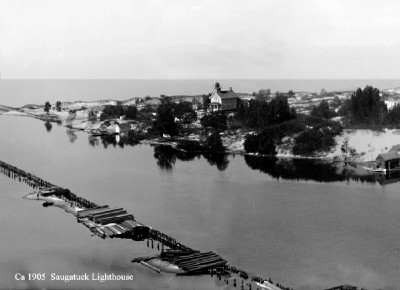
As already noted, the natural harbor at Saugatuck early invited
attention. The general government** was called upon to assist in the
improvement of the harbor and river,
and down to January, 1880, had expended over $100,000 for that purpose.
The people of the locality have also expended upwards of $30,000 upon
the river and harbor, but all the necessary works are not yet erected.
Although vessels of moderate draft may now enter the harbor, there is
need of an extension of the south pier at least four hundred feet to
adfflit craft of a larger class, and to this end Congress is now being
appealed to for further help. The volume of water discharged by the
Kalamazoo River is claimed to be greater than that of any other stream
emptying into Lake Michigan on the eastern coast, except, perhaps, Grand
River. Kalamazoo Lake, three miles from the river's mouth, is half a
mile wide by three-fourths of a mile long, being large enough to contain
at one time all the vessels sailing on the lake, and having an ample
depth of water to accommodate the largest of them.
**Details of any and all bills proposed and or passed by Congress related to Saugatuck Harbor can be found in the Library of Congress.
An example would be a 19 Feb 1836 Senate resolution "That the Secretary
of War be requested to transmit to the Senate a copy of the report,
survey, plan, and estimate for improving the harbor at the mouth of
Kalamazoo river, of Lakes Michigan".

Interest in improvements to the harbor were in large part due to the proposed Clinton - Kalamazoo Canal.
In the 1838 report of Jarvis Hurd on the canal to the Commissioners of
the Board of Internal Improvement of the State of Michigan, found in 'Documents Accompanying the Journal of the Senate of the State of Michigan,'
John A. Kerr & Company, Printers to the State, 1838,
Hurd writes: "The Kalamazoo river, near its mouth, is a natural, and
safe and commodious harbor suificiently deep to float the largest
vessels that sail on the western lakes when once within the bar. A
severe storm at the time of terminating the survey at the mouth of the
river rendered the examination of the bar impracticable."
Via the State Archives, on July 20, 1838 the first shovel full of dirt
was turned in an effort to link Lake St. Clair and Lake Michigan via the
Clinton-Kalamazoo Canal.
The canal was to start at the mouth of the Clinton River near Mt.
Clemens and run west through Howell and Hastings and connect with the
Kalamazoo River to Lake Michigan. Construction was halted in the early
1840s due to financial troubles after only 16 of the planned 216 miles
had been completed.
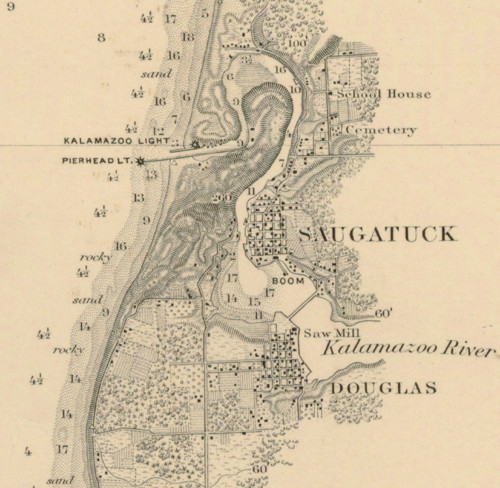
**To the right is a detail from the 1895 nautical chart "Lake Michigan,
Coast Chart No. 7, South Haven to Grand Haven" available on-line from NOAA's Office of Coast Survey Historical Map & Chart Collection. This chart was first published in 1877 by the U. S. Army Corps of Engineers.
The images were about 44 3/8 inches by 30 1/16 inches originally. The 1905 version sold for 15 cents.
In 1837 Saugatuck contained, besides numerous Indians, the families of
W. G. Butler, Daniel and Benjamin Plummer, Johonnett & Crosby,
Stephen A. Morrison, a Mrs. Jones, and Jas. McLaughlin (a
ship-carpenter), besides a floating population of lumbermen and other
laborers, without families.
In 1846 the village, showing but slight improvement, still boasted the
presence of some Indian families, and of those of Morrison, M. B. Spencer, Butler, Nichols, McLaughlin, and Saml. Underwood
(a shoemaker). The place made exceedingly slow progress, and at one
period not long after 1837 was abandoned by almost all its inhabitants
except Mr. Morrison's family.
On the 25th of July, 1841, John Billings,
with his wife and six children, the wife of McLaughlin the
ship-builder, with her child, R. A. McDonald**, and an Irishman (name
unknown) were passing up the river in a small boat, when the craft
accidentally capsized, and five of the twelve persons on board were
drowned, viz.: Mrs. Billings, three of her children, and Mrs.
McLaughlin.
**This is most likely Robert A. McDonald (1820 - 1889)
and would either be Abigail (McDonald) McLaughlin's 1st cousin or
brother. The problem is that Robert A. McDonald's father is stated to be
James McDonald of Penobscot county, Maine, Abigail (McDonald) was born
in Penobscot county, Maine with her father stated as being William
McDonald. However, Robert's mother, Nancy (Brown) McDonald is stated to
be the aunt of Arvilla (Powers) Smith, the wife of Rev. George N. Smith.
Arvilla (Powers) Smith
mother is said to be Mary (Brown) Powers, but James McLaughlin is stated
to be the brother-in-law of Arvilla (Powers) Smith. In addition, Robert
A. McDonald named a daughter Abigail McDonald.
The Newark assessment-rolls previous to 1840 are either unobtainable or
illegible, and as the best that can be done the names of the tax-payers
living in the township in 1840 and 1843 are here given:
1840.- Levi Loomis,
S. A. and S. Morrison, James McLaughlin, J. B. Bailey, agent for Green
Mitchell k Co., J. C. Hale, Benjamin Plummer, L. Jones, James Haines,
Mr. Wood, A. Webber, Josiah Martin, S. D. Nichols, Crosby & Co., J.
V. Ham, agent for Wilder & Co., Moses Nichols,
"tavern-keeper and vender of ardent spirits," A. Morrison,
"tavern-keeper, and sells no ardent liquor." The assessed acres
aggregated 73,816, and the total town valuation was $174,709. The
assessors were J. C. Hale, B. B. Wilder, and Benjamin Plummer.
1843. - J. C. Hale, H. Hutchins,
J. W. Wadsworth, Jacob Barragar, L. Jones, William G. Butler, C. H.
Bartlett, Benjamin Plummer, S. D. Nichols, James McLaughlin, S. and S.
A. Morrison, Robert McDonald, Henry Pritchard, P. J. Cook, agent, J. W.
Miles, William F. Hale.
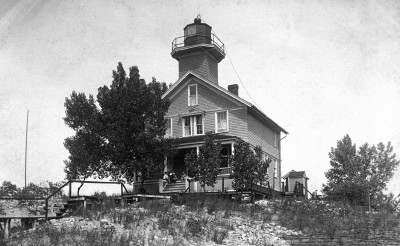
**The Light House pictured above was distroyed by a tornado in 1956. For more infomation on the harbor and lighthouse go to Seeing the light - Kalamazoo River Lighthouse.
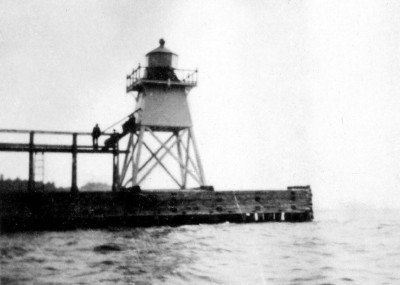
In 1838 the government erected at the mouth of the Kalamazoo River a
stone light-house, the site of which is now covered by a portion of the
south pier, the channel being now twenty rods north of where it was in
1838. Stephen D. Nichols was appointed the first keeper, and retained
the place about six years. In 1859 the tower began to show signs of
decay, and was replaced by a brick structure. The latter wore out in
turn, and was succeeded in 1875 by the wooden tower now adorning the
extremity of the south pier.
Until 1851, when S. D. Nichols built and opened a store in the village,
Saugatuck boasted no such establishment of any pretensions whatever, and
until that year the villagers generally did their trading at the mouth
of the river or at Singapore. In 1854, Wells & Johnson, the
mill-proprietors at Saugatuck, opened a general store at that place,
much to the gratification of the townspeople. After that the village
began to grow and stores to multiply.
When Wayne Coates came in 1849, and opened a drugstore in a house built
by Daniel Plummer, there was no store nearer than Nichols', at the mouth
of the river, or Artemas Carter's, at Singapore. The town was a forest,
and included only the families of William G. Butler, S. A. Morrison,
Samuel Underwood, Ellas M. Dibble, M. B. Spencer, and perhaps one or two
others. In 1865 there were the stores of John Burns, S. A. Morrison, B.
W. Phillips, R. P. Kleeman,
and H. D. Moore ; Dunning & Hopkins and H. D. Moore's saw-mills ;
Ebmeyer & Kuffin and Blanchard's shingle-mills ; a pail-stave
manufactory; and two hotels. Main Street from Nichols' to Morrison's had
but two or three buildings, and beyond Dunning's sawmill the land was
covered with growing timber. The village now contains a dozen mercantile
establishments of all kinds, which carry on a business of no
insignificant proportions.
The only grist-mill** built at Saugatuck village was erected in 1866 by George P. Heath, and destroyed by fire in November, 1879.
**In the 1859, 1860, and 1863 Michigan State Gazetteer, and Business
Directories in reference to Saugatuck it states the village had one
steam powered flour mill operated by George N. Dutcher.
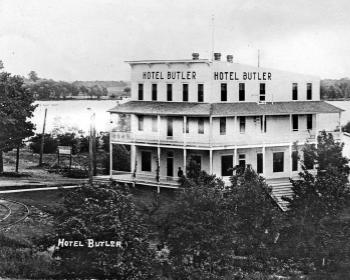
This Heath Grist Mill is the future Hotel Butler at the river's edge on
the south end of Butler street. At present, this is the location of the
Butler restaurant and have all been built on the same foundation, they
are all the same building. The 21 Jul 1899 Commercial Record states:
Guard, Fairfield & Co., of Allegan are negotiating with A. N. Nysson
for the purchase of the grist mill property here. Then on 4 Aug 1899
reports: Work on repairing the grist mill continues.
On 18 Aug 1899, the paper reports: The Saugatuck Roller mill (grist mill
owned by Guard, Fairfield & Co.) started up Thursday, grinding
feed. They expect to be making flour in a few days. On 20 Oct 1899, The
Saugatuck millers, shipped 8,000 pounds of flour to Liverpool one day
last week.
CR 23 Feb 1900, Owing to the scarcity and high price of fuel, the
Saugatuck Roller Mills will shut down for a couple of months. It is
possible that when they start up again the power will come from
gasoline, which is far more economical.
CR 5 Jul 1900, Sam Guard, the proprietor of the Saugatuck flour mill,
was here Thursday. There is some prospect that he will dispose of the
mill building and move the machinery to Allegan, to start a new roller
mill in the busisness portion of that town, where a part of the old
Chaffee block stood before the fire. -Fennville Herald. Mr. Guard
informs us that he has no intention of moving the mill to Allegan, and
that the editor of the Herald had no authority for the above paragraph.
It is merely some more of Bro. Bassett's "guess work."
CR 11 Jan 1901, The grist mill property has been sold and the building
will be converted into a three-story hotel. The village board has agreed
to rent a plot of land adjoining the mill property and owned by the
village for $50 a year for as long a time as the building shall remain a
hotel.
CR 1 Feb 1901, The grist mill property has finally been sold, the
purchaser being Mrs. W. G. Phelps [W. G. Phelps].
Work will be commenced soon and the building will be remodeled into an
up-to-date hotel. It will be three stories in height, with laundry,
etc., in the basement. Mrs. Phelps has also purchased of Griffin &
Henry some land lying just south of the building.
A post-office was established at Saugatuck, as already mentioned, in
August, 1835, and R. R. Crosby appointed postmaster. The mail-bag was in
those days seldom very well filled, and, in fact, for a considerable
period came down the river from Allegan upon rafts at such uncertain and
irregular times as were most convenient.
In 1840, Samuel Morrison was appointed mail-carrier, and rode at
regularly appointed dates on horseback between Saugatuck and Allegan.
William G. Butler succeeded Crosby, and then followed S. A. Morrison,
who gave place in 1860 to Ward. Samuel Johnson was the next occupant of
the office, being followed successively by B. W. Phillips, S. A.
Morrison (second term), Hiram Ellis, Samuel Johnson (second term),
William V. Johnson, and George T. Arnold, the present incumbent.
In 1870, Saugatuck was made a port of entry**, and in that year H. R. Ellis was appointed collector of customs. The present collector is George T. Arnold.
**The 1873 Polk's Michigan State Gazetteer and Business Directory states
"Until the establishment of the Custom House here in 1868 this place
was known to the lake trade as Port Kalamazoo."
The first white child born in the township was a daughter of William G.
Butler. Her birth occurred in the fall of 1834, and her death early in
1835, she being also the first white person to die in the township. The
second birth was that of Andrew,
son of Benjamin Plummer, on the 1st day
of January, 1835. He is now a resident of the township of Ganges. The
first adult person who died was the wife of William G. Butler**.
**Mary (Wells) Butler was the 1st wife of William Gay Butler, who died in 1385. Eliza (McKennan) Butler was his 2nd wife who died in 1843. Emily (Loomis) Butler was William's 3rd wife, who died in 1864.
The first marriage was that of John C. Wooster, a lumberman, and Ruth Johonnett,
in June, 1837. The second was that of S. A. Morrison and Elizabeth
Peckham. They were married in the public hall at Singapore, by Rev. Mr.
West, of Otsego., Mr. West was a Universalist preacher, and used to come
over from Otsego now and then to hold services in the hall at
Singapore, which was also occasionally occupied by the Methodists for
the same purpose.
The school-house near Singapore was the first one built in the town.
Previous to its erection Jane Powers taught the children of some of the
settlers, as did Elizabeth Peckham, who came from Allegan in response to
a request from Benjamin Plummer, and taught in the house of the latter,
near his saw-mill.
A Methodist Episcopal society, now extinct, was organized in Saugatuck
village about 1865, and endured until 1875. Revs. Loomis, Benson, Hoyt,
Cawthorne, Thurston, Cowen, and Pengally were among the earlier pastors.
Rev. Mr. Cawthorne came hither, vid the lake, from Muskegon, with his
family and household effects, on board a tug. While entering the river
the tug capsized, and Mr. Cawthorne's two children were drowned.
Dr. Chauncey B. Goodrich,
who came to Saugatuck in 1843 and entered upon the practice of
medicine, was the first physician of the village. He soon removed to
Ganges, but remained for many years the only physician in the western
part of the county. He died in Ganges in 1879. His successor in village
practice was Dr. Flowers, who made his appearance at Saugatuck in 1857,
and practiced there until his death, in 1859. Dr. S. L. Morris followed
him, and remained until 1865. Dr. H. H. Stimson,
who began to practice in the county in 1853, went to Saugatuck from the
eastern part of Allegan in 1860, and since that time has been steadily
in practice there.
Dr. J. B. Cook,
who is still a Saugatuck physician, entered upon his professional
service in that village in 1862. After him came Dr. David McLean, who
made but a brief stay, and then passed over to Douglas, where he tarried
until 1879. Dr. Alex. McRca,who came to Saugatuck in 1865, remained
until 1871. Dr. R. Pengally, and his son-in-law. Dr. Charles
Chamberlain, began practice in 1871, and moved away in 1873. Dr. Charles F. Stimson practiced from 1872 to 1879, when he died. Dr. E. B. Wright,
who died in Saugatuck in 1879, had practiced in the village eleven
years. The village practice is at present confined chiefly to Drs. H. H.
Stimson and J. B. Cook, the only resident physicians.
Saugatuck's first resident lawyer was a Mr. Pratt, who opened an office
in 1868, went shortly afterwards to Holland village, and lives now in
Grand Haven. His successor, J. S. Maury, came in 1871, and remained two
years. He now lives in Nebraska! The third lawyer was R. L. Newnham, who came in 1876, and is yet in practice. The only other resident lawyer is D. A. Winslow, who removed to the village from St. Joseph, Mich., in February, 1880.
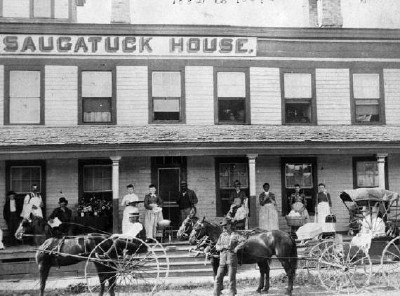
In 1840, Moses Nichols kept a tavern at the mouth of the river, and in
the same year S. A. Morrison's residence at Saugatuck was commonly
regarded as a house of entertainment where travelers could find lodging
and refreshment, but no spirituous liquors. Mr. Morrison kept open house
in that fashion until 1852, when by the donation of a village lot he
induced R. S. Smith, of Battle Creek, to come over and build the
Saugatuck House. Mr. Smith was accidentally drowned in the Kalamazoo
River.
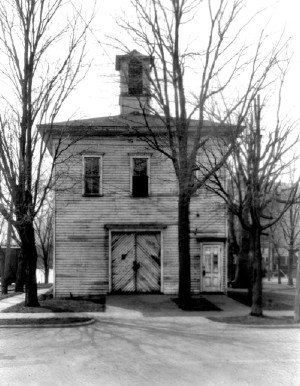
Saugatuck village was incorporated by the board of supervisors of
Allegan County in 1868, and on the first Tuesday in March of that year
the first election was held. H. B. Moore was chosen President; Hiram R.
Ellis, Clerk; Diodet Rogers, Treasurer; R. B. Newnham, Marshal; and George E. Dunn, James Hibbodine, Solomon Stanton, Warren Cook, S. A. Morrison, and Samuel Johnson, Trustees. In 1869, H. B. Moore was President; Hiram R.Ellis, Clerk; and J. M. Pond,
Marshal. In the winter of 1869-70 the village was reincorporated by an
act of the Legislature. The records having been destroyed by fire, a
complete list of the village officials cannot be obtained. The following
gentlemen have served as presidents, clerks, and treasurers during the
years mentioned;
1870, John C. Bacon; 1871, S. A. Morrison; 1872, Randolph Densmore; 1873-74, Isaac Wilson; 1876-76, D. L. Barber; 1877, L. B. Coates; 1878, H. B. Moore; 1879, A. B. Taylor.
1870, Hiram R. Ellis; 1871-72, Henry Bird, Jr.; 1873-79, R. B. Newnham.
1870, L. O. Tanner; 1871, J. B. Bacon; 1872, John Nies; 1873-76, A. B. Taylor; 1877-79, C. Whitney.
The village trustees serving in 1879 were D. L. Barber, John Nies, David White, W. B. Griffin, George E. Dunn, and John Priest.
Saugatuck has been frequently visited with serious conflagrations,
including (aside from those which have merely destroyed dwellings) the
burning of H. D. Moore's store in 1866; that of O. R. Johnson & Co.
's large store and the Empire Billiard-Room**, with a large public hall,
in 1876 ; that of the Ebmeyer shingle-mill, Kleeman's store, and
Miller's saloon in the same year ; that of S. H. Morrison's store in
1879 ; and that of Heath's grist-mill, also in 1879.
**CR 26 Dec 1868, adv. Go to J. Wilson's Empire Saloon for a dish of fresh fish. Via 1873 Allegan County Atlas, John Wilson
was the proprietor of Empire Billiard Room, and dealer in choice wines,
liquors and cigars. In 1877 John Wilson was the proprietor of the
Saugatuck House.
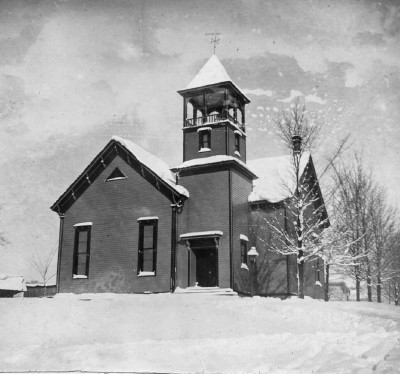
In accordance with previous notice, a meeting was held at the Saugatuck
school-house on the 11th of January, 1860, to consider the propriety of
organizing a Congregational Church. Rev. Thomas Jones was appointed
moderator, and Rev. D. Werts scribe. The church council included Rev. N.
Grover and Deacon D. McDonald, of South Haven; Rev. D. Wert and Deacon
O. D. Goodrich, of Allegan ; Rev. L. H. Jones and Deacon A. Norton, of
Cooper; Rev. D. S. Morse, of Otsego; Rev. Thomas Jones, of Galesburg ;
and Rev. E. Taylor, of Kalamazoo. The church was organized without
delay, and included the following members: Rev. C. H. Eaton, F. B. Wallin, Moses Philbrook, Alanson Gardner, Mrs. M. P. Eaton, Mrs. Orcetia Wallin,
Mrs. Mary Philbrook, Mrs. Marila Gardner, Mr. and Mrs. Elnathan Judson,
John Harris, Mrs. Hannah Cook, Andrew Alexander, Miss Sarah Jane
Cowles.
The first pastor was Rev. C. H. Eaton, and the first deacons Alanson
Gardner and F. B. Wallin. Rev. J. C. Myers succeeded Mr. Eaton in May,
1862, and remained in charge until 1868. Rev. J. F. Taylor then entered
upon the pastorate, and continued in it until 1878. Rev. W. C. Allen
followed for a brief season, and then came Rev. W. B. Sutherland, the
present pastor.
During the summer after its organization the society built a church
edifice, which was the first house of worship erected in the town. In it
also was held Saugatuck's first "war-meeting" upon the outbreak of the
Rebellion, in 1861. The deacons of the church are F. B. Wallin, H. L.
House, and George E. Dunn. The trustees are George E. Dunn, F. B.
Wallin, H. L. House, H. D. Moore, George H. Thomas, and M. B. Williams. The membership numbers about 80.
This church was organized in Morrison Hall**, June 21, 1868, with the following members: A. C. Zwemer and wife [Lanegje Knoll Zwemer],
H. Van Spyker and wife, G. Jonkhoff and wife, M. De Boe and wife, I.
Zwemer and wife, I. G. Neimeizer and wife, J. J. Koke, J. Neis, M. Van
Leuwen, Arent Zwaavink, Mrs. P. Kallewoord, Mrs. G. Sluiter. The first
elders were J. J. Koke and A. C. Zwemer; the first deacons, G. Jonkhoff
and M. De Boe. But two pastors have served the church,óRev. D. Broeck,
from May 1, 1870, to March 25, 1875, and H. E. Neis, from Nov. 5, 1876,
to Deo. 30, 1879, the pastorate being now vacant. The present membership
numbers 55, and the officers are as follows: Elders, J. Ensing, H. Van
Spyker, and M. De Vries; deacons, A. C. Zwemer, M. Van Leuwen, and J.
Raman. The Sunday-school superintendent is J. Ensing, and the school
membership about 40. The house of worship now in use was erected in
October, 1868, and enlarged in October, 1874.
**Morrison Hall would be Stephen A. Morrison's store building located on the southeast corner of Butler and Culver streets.
This organization was formed in September, 1868, by J. R. Taylor,
who was chosen as the first rector, and who continued in charge until
1878, when he was succeeded by Rev. E. W. Flower, the present rector.
The members of the church at the organization were 0. R. Johnson and
wife, F. B. Stockbridge and wife, R. B. Newnham and wife, H. H. Stimpson
and wife, J. F. Geer, A. B. Taylor, William Dunning and wife, Mrs.
Breuckman, Mrs. Merrill, Thomas Donald and wife, Mr. and Mrs. Moses
Nash, Pierce Abbey, Mr. and Mrs. S. G. Moreland, David White and wife,
Isaac Wilson and wife. The village school-house was used as a house of
worship until January, 1873, when the edifice now in use was first
occupied. Its cost was about $4000. The first wardens were Robert G.
Anncsley and Pierce Abbey.
The vestrymen were F. B. Stockbridge and H. H. Stimson. There are now 40
members of the church, and 50 of the Sunday-school. The school is in
charge of A. B. Taylor, superintendent, assisted by six teachers. The
rector, residing at Holland, holds services in Saugatuck once every
fortnight.
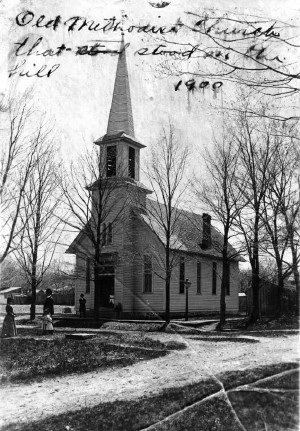
**SAUGATUCK TOWNSHIP by David Schwartz, excluding the statement above in
the section on Biths and Marriages, "A Methodist Episcopal society, now
extinct, was organized in Saugatuck village about 1865," it makes no
mention of the Methodist Church in Saugatuck, which is located at the
northwest corner of Griffith and Mason streets.
While true in 1881, the Michigan Directory states "The village contains
Congregational, Dutch Reform and Episcopal churches," the 1897 Polk
Directory states "The village contains Congregational, Wesleyan
Methodist, Methodist Episcopal, and Episcopal churches."
CR 25 Nov 1898 - The old Congregational church bell goes to the Wesleyan
Methodist Church.
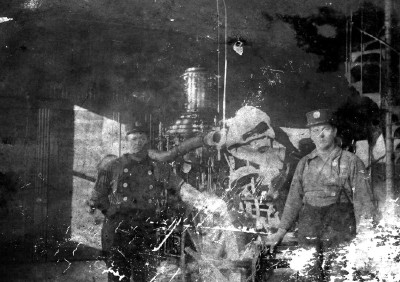
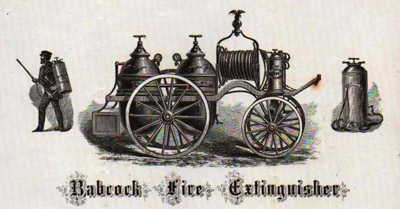
In January, 1871, the village purchased a hook-and-ladder apparatus and
placed it in charge of the marshal, the villagers at large being the
working force whenever the machine was called into service. Shortly
afterwards 200 pails were bought at public expense, and distributed in
convenient places for use in case of fire. In 1873 a Babcock
extinguisher was purchased, and a fire department organized with 30
members, of which James M. Pond was chief engineer, and A. H. Gardner
first assistant. The extinguisher, which cost $2000, proved a failure,
and was replaced with a hand-engine and hose-cart, which now do
efficient service. The engine company has 12 members, A. H. Gardner
being the foreman. J. P. Hancock is the
foreman of the hose company, which is also provided with a
hook-and-ladder apparatus. It has 8 members. The chief engineer of the
department is John Wilson.
**For more information of Saugatuck's Fire Department download the "Hand Drawn Hose Cart" pdf.
This association was instituted Oct. 17, 1872, with 5 members, viz.: Amos B. Titus,
E. O. Cole, Henry Ebmeyer, David White, and Joseph Fischer. The first
officers were Henry Ebmeyer, N. G.; David White, V. G.; B. O. Cole, Sec.
The Noble Grands since Mr. Ebmeyer's term have been David White, Isaac
Wilson, John Wilson, John Priest, James A. Houtcamp, Edmond Skinner, James M. Pond, P. H. Hancock, Samuel Clipson, J. G. Williams, William F. Metzger,
C. M. Cook, K. G. Annesley. In 1878 the lodge erected a fine building,
in the third story of which the Todge-room is located. The second story
is used as a public hall. The active members in January, 1880, numbered
83. The officers at that time were K. G. Annesley, N. G.; A. B. Taylor,
V. G. ; J. M. Pond, Sec.; S. D. Nichols, P. Sec. ; W. B. Smalley, Treas.
**Independent Order of Odd Fellows
Saugatuck Encampment was instituted Aug. 7, 1873, with William Corner,
Samuel Clipson, Isaac Wilson, J. A. Houtcamp, John Wilson, H. Ebmeyer,
John Priest, A. B. Titus, and Charles H. Chamberlain as the first
members. The first officers were H. Ebmeyer, C. P.; Isaac Wilson, H. P.;
John Wilson, S. W.; John Priest, J. W.; Samuel Clipson, Treas. The
membership is now 24, and the officers as follows: Karl Ebmeyer, C. P.;
J. B. Cook, H. P.; A. B. Titus, S. W.; J. G. Williams, J. W.; J. M.
Pond, Scribe; John Priest, Treas.
This lodge was demitted from Dutcher Lodge, of Douglas, and instituted
Jan. 26, 1876, with James G. Williams, W. M.; Reuben T. Rogers, S. W.;
and L. W. Grant, J. W.; the total membership being 16. The Masters since
Mr. Williams have been William P. Hanson and W. B. Griffin. The present
membership is 34, and the officers are as follows: J. G. Williams, W.
M.; Amos H. Gardner,
S. W.; John Martelle, J. W.; E. J. Tedmon, Sec.; Henry Bird, Jr.,
Treas.; Jacob Metzger, L. D.; Joseph Elliott, J. D.; Lorenzo W. Grant,
Tyler. Regular sessions are held in Masonic Hall, Griffin's Block.
**F and AM stands for Free and Accepted Masons
This organization was formed in April, 1879, by Dr. Reynolds, a noted
temperance working advocate; Morrison's Hall, the scene of the first
meeting, being crowded with an enthusiastic assembly. About 80 persons
enrolled themselves as members of the club, and chose Capt. Reuben T. Rogers
president and C. B. Scott secretary. The club has continued to flourish
to the present time, and through the medium of weekly public
assemblies, at which literary and musical entertainment is offered,
promotes the cause of temperance in a very satisfactory manner.
This association of the ladies of Saugatuck was organized March 19,
1879, and the hearty encouragement it has received is shown by the fact
that it now contains 90 working members. Weekly business sessions are
held, and every Sunday a gospel-meeting invites the attendance of the
general public. The officers are Mrs. H. D. Moore, President; Mrs.
George E. Dunn, Mrs. C. E. Wells, and Mrs. Edmond Skinner,
Vice-Presidents ; Mrs. F. B. Wallin, Sec.; Mrs. Z. B. Wasson, Treas.
The Juvenile Temperance Society, organized in June, 1879, has now a
membership of 78. Van Wallin is President; Winnie Moore, Sec. ;
Ellsworth Houtcamp, Treas.; and Hattie Wallin, Organist.
As long ago as 1835, or perhaps before, William G. Butler stoutly
maintained that the country in the neighborhood of Saugatuck was well
adapted to the growth of peaches, and he predicted, moreover, that the
region round about would one day be famous and wealthy as a fruit
producing district. That Mr. Butler was right in his conclusions time
has abundantly proven.
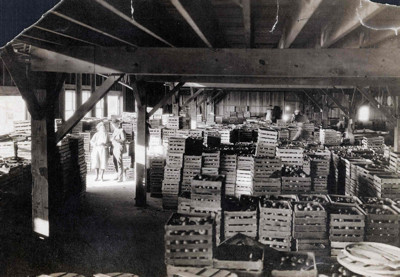
Peaches were cultivated to a moderate degree for home consumption in
1840, and were thus grown in a small way every year thereafter, but it
was not until about 1869 that the culture of the peach was made an
important commercial industry, and thus it has expanded annually to the
present time into an enterprise which engages the attention of thousands
of people, lays under tribute a vast area of country, and yields yeariy
the return of thousands of dollars.
The fruit-belt under consideration includes those portions of Allegan
and Van Buren Counties bordering Lake Michigan, and, according to
reports gathered at the close of the season of 1879, included 600,000
peach-trees, yielding an estimated product of 3,000,000 baskets of fruit
yearly. Reports made to the Saugatuck and Ganges Pomological Society,
November, 1879, set forth that in Saugatuck 1200 acres were set to
peach-trees, and that over 400 acres were in full bearing. Estimating
100 trees per acre, and 5 baskets per tree, the 1200 acres would give au
annual yield of 600,000 baskets. From similar reports it is learned
that in Western Allegan during 1879 there were shipments of peaches as
follows:
Douglas: Baskets 145,420; Creates 2,173
Saugatuck: Baskets 30,000
Fennville: Baskets 137,500
Mack's Landing: Baskets 12,000
East Saugatuck and Richmond: Baskets 10,000
Total: Baskets 334,020; Creates 2,173
During 1879 the amount paid at Saugatuck and Douglas villages for peaches purchased at those points aggregated $49,200.
Among the prominent peach-growers of Saugatuck township may be mentioned
Williams & Son, R. M. Moore, P. Purdy, Sophia Schulfz, Thomas Gray,
J. Grouse, Robert Reid and F. C. Kile, William Corner, William Cummings, Joshua Weed,
Dressier & Patcher. Williams & Son and R. M. Moore, having
respectively about 10,000 trees, are ranked the largest producers.
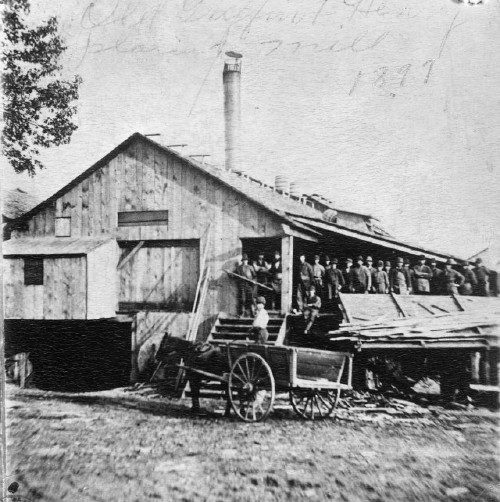
As has been seen, this was, during the pioneer period, the most
important business, not only of Saugatuck, but of all Western Allegan,
and it continued so for many years. Saugatuck was, until a few years
ago, a place of many sawmills, but the gradual exhaustion of the timber
caused the decline of the business, until now there are in Saugatuck and
Douglas but three mills, and for two of these the supply is becoming
very scanty. The first steam saw-mill built in Saugatuck village or
vicinity was erected in 1846, by M. B. Spencer, upon the site now
occupied by the mill of Williams,
Griffin & Co. Mr. Spencer had also a lumberyard at the mouth of the
river. He carried on the mill until 1850, when he sold it to Wells
& Johnson.
Williams, Griffin & Johnson carry on at Saugatuck the saw-mill put
up in 1852 by Dunning & Hopkins. Here 40 men are employed in turning
out lumber, shingles, lath, and siding. The capacity of the mill is
about 52,000 feet of lumber daily. This firm is likely to continue in
the business at Saugatuck for some years, as it has an assured and ample
stock of logs.
Ebmeyer & Neis now control the Douglas mill-property, owned in 1879
by Gray & Crouse. From 30 to 40 men were employed during the busy
periods of 1879, and about 50.000 feet of lumber were out daily. In
connection with the saw-mill, there are also large lath- and
shingle-mills. H. B. Moore likewise has at Douglas a saw-mill and
shingle-mill, employing an average of 25 men.
The basket-factory and planing-mill started at Douglas by Weed &
King is now carried on by William Weed. He manufactured in 1879 about
30,000 fruit-baskets.
Hutchinson Bros. & Co. have at Douglas a fine grist-mill containing
five run of stone, and devoted to merchantas well as custom-work. The
site was previously occupied by Crawford McDonald with a grist-mill, of which the present firm became the owners in 1877, and which they have materially enlarged.
C. C. Wallin & Son
are largely engaged in tanning at Saugatuck and Douglas. At the former
place they have an extensive tannery, which employs about 20 men, its
business reaching as high as 30,000 hides yearly. At Douglas they employ
10 men in a tannery confined to the production of sole leather, which
uses about 15,000 hides annually. Among other manufacturing interests in
Saugatuck, now extinct, two important ones were H. D. Moore's extensive
saw-mill and the shingle-mill of Ebmeyer & Palzer, both early
enterprises.
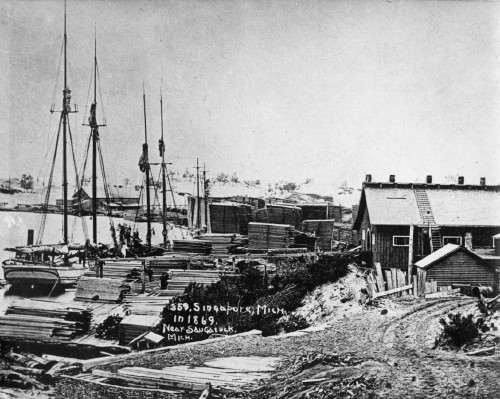
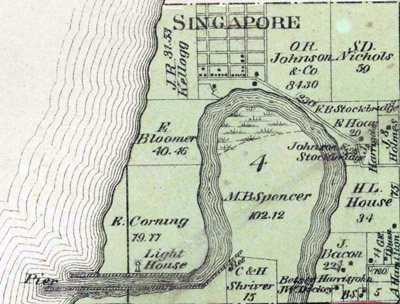
On the [1873] map of Saugatuck township**
there appears in the northwestern corner the village of Singapore, once
a thriving, bustling place, now abandoned by everybody save a few
fishermen, who abide there temporarily during the fishing seasons. In
1837, Oshea Wilder
and sons, of New York, purchased of the Barnes family (the patentees)
considerable tracts of land in Saugatuck township, and proceeded to lay
out a village which they called Singapore.
They arranged to build a large saw-mill at that point, succeeded in
disposing of a good many village lots, and induced quite a number of
settlers to locate there. The mill was built as promised, tenements were
erected for the mill hands, a store was opened by the mill company, and
Singapore started upon its career amid a great flourish of trumpets and
a promise of much prosperity.
The mill company, known as the New York and Michigan Lumber Company,
flourished so well that in 1839 they started the Singapore Bank,
of which Daniel Wilder was chosen president, and Robert Hill cashier. A
good deal of money was issued by the bank in the shape of
handsome-looking notes, which were paid out for mill labor and taken in
again at the company's store, but which belonged, nevertheless, to the
kind of currency known as " wildcat," although that particular species
of wildcat is said to have been a trifle better than the average.
Stephen D. Nichols, who invested in two 80-
acre lots of wild land in support of the bank, says that the money was
good enough at home, but "bless you, you couldn't travel on it any
farther than you could on a piece of sandstone."
**A detail of Singapore in the 1873 Altas can be found at the University of Michigan's Michigan County Histories Images with other maps of the area.
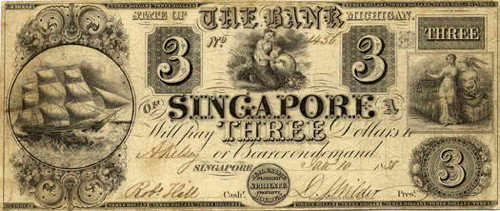
Of course the bank came to grief, as did Wilder & Co., together with
all their enterprises, but James G. Carter & Co., who soon
purchased the various interests, still kept Singapore alive. Its
struggle for existence was, however, a hard one, and, although it was
not utterly abandoned until 1875, it suffered a serious decline long
before that period. The last mill-owners were Stockbridge & Johnson,
who continued business at Singapore until the year last named. The
stock of desirable timber being then pretty well exhausted, they removed
their mill machinery to Mackinaw, and with their departure Singapore
breathed its last.
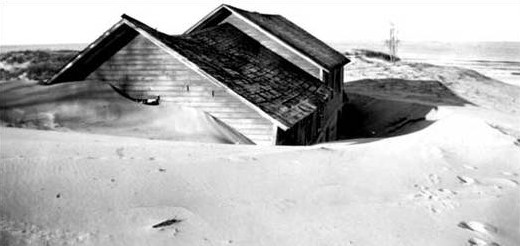
**For additional information read The Historic Significance of the Old Singapore Site Today, By James Schmiechen
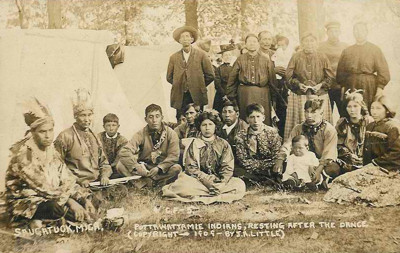
The vicinity of the mouth of Kalamazoo was, from a period long anterior
to the first settlement of the whites down to 1840 or later, a great
gathering-place for the Ottawa and some Pottawattamie
Indians, who came thither from Mackinaw every autumn, scattered through
the country to the eastward to hunt during the winter, and returned to
the mouth of the river in the spring. A full account of these
migrations, of the habits of the Indians, and of the trading-posts which
formerly existed along the Kalamazoo, will be found in Chapters VII. and IX. of the general history.
As late as 1842 there existed near Saugatuck several Indian mounds, but
the plowshares of the settlers soon obliterated these relics of
primeval days. On the hills opposite Saugatuck there were visible until
recently traces of Indian graves, and among them that of a chief called
Wamnus, but there is now no sign to show where they were.
In illustration of the Western fever for paper villages from 1835 to
1838, it may be noted that in addition to Singapore (which did really
become a village) there were the paper town of Kalamazoo Harbor, laid
out at the mouth of the river, the town of Naples, on the river near
Singapore, laid out by parties now forgotten, and the city of Breese,
also on the river, a mile or so above Saugatuck, the site being owned by
a Mrs. Breese. These towns were handsomely depicted upon paper, and
were represented to new-comers and people living at a distance as being
very promising commercial localities, but, unfortunately for their
projectors, they failed to delude anybody, and never rose above the
condition of paper villages.
Settlements in the southern portion of the township did not begin until
some years after the pioneers began to gather at Saugatuck and
Singapore. On the town-line road, and near there, H. S. Braman, James C.
Hale, William Corner, Horace Fuller, William White, Henry Oliver, and
Josiah Martin (an early resident in Singapore) were among the first to
locate themselves and become permanent residents. On the lake-shore the
list of pioneers included Kobert Reid, James McVey (now living in
Ganges), John Strahan, J. W. Gill, the Kiles, and others. K. A. McDonald
and Wm. Scovell have already been alluded to, while among other early
comers may be mentioned John Kenter, H. Weeks, the Kiles, Henry Smith,
Philetas Purdy, R. M. Moore, William Plummer, William Cummings, J. S.
Grouse, and F. Schultz.

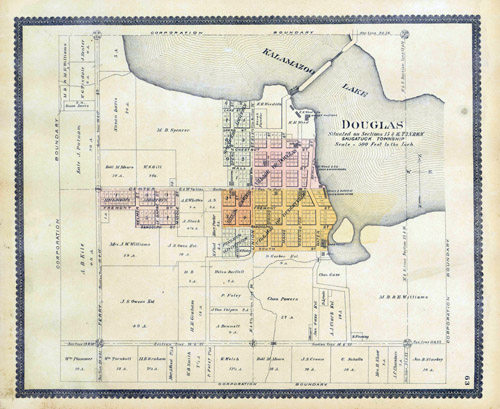
The first settlers upon the site of Douglas village, and indeed the
first settlers in Saugatuck township on that side the lake, were R. A.
McDonald and William Scovill,
who, in 1847, settled upon land in section 16, located for them the
year before by M. B. Spencer. That was, however,
long before the village of Douglas was even thought of. Mr. Scovill is
dead, but Mr. McDonald still lives on section 22. The first effort
towards creating a village at that point was made by Jonathan Wade,
in 1851. He bought lot 3 on section 16, built a house thereon,
interested Wells and Johnson in the project, and set about building a
saw-mill on the site now occupied by Ebmeyer & Neis' mill. He then
laid out a village on the south half of his lot, and called it
Dudleyville, in honor of his brother, Dudley Wade, of Canada. Presently,
William F. Dutcher
bought the north half of Wade's lot, including the mill, and on that
tract laid out a village, which he named Douglas at the suggestion of F.
H. May, who wished thus to commemorate the town of Douglas, the capital
of the Isle of Man. Thus it appears there were two villages, known as
Douglas and Dudleyville, separated only by the width of a single street.
By these names they were known until the incorporation of the entire
tract as Douglas, in which were included, besides the two village plats,
Spencer's and other additions.
William Bush, who was interested with Dutcher in the saw-mill, opened a
store near the mill, the first one in the village. Shortly after 1861,
Wade built the tavern called the Douglas House, the mill business began
to expand, Daniel Gerber
started the tannery now owned by Wallin & Sons, and the locality
soon began to assume a village like appearance, although in 1861 the
families were still but few in number. The building, by H. F. Marsh, of
the saw-mill now owned by H. B. Moore, materially aided the advancement
of the village, but it was not until the region round about began to
develop as a rich fruit-country that Douglas attained decided
prominence. Since that time the village has been an important
shipping-point for fruit as well as lumber, and, although the latter
interest is declining, the former is destined to remain permanently
valuable.
The village now has two stores, kept respectively by Thomas Gray and D. C. Putnam.
Mr. Putnam was appointed the postmaster at Douglas when a post-office
was established there, in 1868, and has held the position from that time
until this. The town contains a fine Masonic hall, a union school, two
churches, two large saw-mills, a tannery, a basket-factory, a
grist-mill, and the ordinary minor village industries.
The oldest settlers now living in the village are M. B. Spencer and John Ryan, who became residents in 1861.
David McLean, the first physician of Douglas, opened his office in 1864,
and practiced until 1879, being the only doctor in the village. Upon
Dr. McLean's retirement. Dr. A. H. Parks, the present resident
physician, took possession of the field.
W. A. Woodworth, the only lawyer who has ever resided in the village, located there in 1876, and is still in business there.
During August and September, 1870, the citizens of Douglas met several
times to consider the matter of incorporating the village, and appointed
C. A. Ensign, D. W. Wiley, and David Porter, Sr.,
an executive committee on the subject. Upon the prayer of the citizens
the village was incorporated by the supervisors, on the 14th of October,
1870, and C. A. Ensign, D. C. Putnam, and D. Gerber were appointed
inspectors of election. At the first election, held Dec. 5, 1870, at D.
Gerber's office, the total number of votes cast was 41. The names of
those chosen annually to serve as president, trustees, clerk, and
treasurer are as follows:
1870. - President, C. A. Ensign; Trustees, M. B. Spencer, Homer Manvil,
D. "W. Wiley, Thomas Gray, D. Gerber, and T. B. Dutcher; Clerk, D. C.
Putnam; Treasurer, Crawford McDonald.
1871. - President, D. W. Wiley; Trustees, J. S. Crouse, Geo. N. Wade, J. S. Owen; Clerk, John Kirby; Treasurer, L. A. Upson.
1872. - President, D. W. Wiley; Trustees, J. S. Owen, Thomas Gray, Crawford McDonald; Clerk, John Kirby; Treasurer, Jos. Gerber.
1873. - President, Reuben Smith; Trustees, Danl. Gerber, Robert Moore, J. S. Crouse; Clerk, John Kirby; Treasurer, Thomas Gray.
1874. - President, Thos. Gray; Trustees, J. S. Owen, Banl. McLean, J. S. Payne; Clerk, John Kirby; Treasurer, D. W. Wiley.
1875. - President, Thos. Gray; Trustees, M. B. Spencer, Wm. Plummer, Geo. Sams; Clerk, John Kirby; Treasurer, Thos. Gray.
1876. - President, D. McLean; Trustees, Danl. Gerber, D. Porter, H. Walbreight; Clerk, D. C. Putnam; Treasurer, D. McLean.
1877. - President, D. McLean; Trustees, P. Foley, Wm. Plummer, M. B. Spencer; Clerk, John Kirby; Treasurer, D. McLean.
1878. - President, W. S. Gill; Trustees, D. McLean, Saml. Reid, J. S. Crouse; Clerk, John Kirby; Treasurer, D. McLean.
1879. - President, J. S. Payne; Trustees, F. C. Kile, D. C. Putnam, W. S. Gill; Clerk, N. C. Firman ; Treasurer, D. McLean
This religious body had its origin in what was known as the Newark
Class, formed in 1862, which had a membership of ten persons, and was
attached to the Newark Circuit. Among the first members were Mr. and
Mrs. Wade, Mrs. Carmon, Mrs. Butcher, Marshal Dye, Mrs. Deitrich, Nelson Wade
and wife, and Geo. Dunn. Geo. Dunn was the first class-leader, and the
Rev. Mr. Bliss the first pastor; The village school-house, which was at
first used for services, was replaced, in 1870, by the present church
edifice, the only one in Douglas.
Latterly membership of the church has become quite small, although the
numerous revival meetings held during the past winter have reinvigorated
it to a considerable degree. Divine services and sessions of the
Sabbath school are held every Sunday. The present pastor is Rev. N. M.
Steele, and the class-leader is Robert Elliott.
During the year 1874, Elder Kenyon, of Monterey, visited Douglas and
organized an Advent Church of 16 members at the house of David McCullom.
At that time William Burnet was appointed leader, and has served in
that capacity to the present time. Robert Reid, who was
chosen the first deacon, sfill occupies that office. Public worship has
been observed regularly every Saturday since the organization. Until
1879 various temporary places were occupied for this purpose, but during
that year a building in the village was purchased and transformed into a
convenient church edifice. The membership is now about 40. The
Sabbath-school, in charge of Robert Reid, as superintendent, was
organized in 1878, and has an average attendance of 25.
This body was organized under dispensation, April 9, 1866, and chartered
Jan. 10, 1867. The first officers were Thos. B. Dutcher, W. M. ; H. H.
Stimpson, S. W.; and James G. Williams, J. W. The membership has been as
high as 80, but stands now at 64, Saugatuck Lodge having been demitted
in 1876. In 1875 the lodge built the Masonic hall in Douglas at a cost
of $1400, in which it now has commodious and handsome quarters. The
present officers are W. S. Gill, W. M.; F. C. Kile, S. W.; S. C. Reid,
J. W.; T. C. Gray, Sec.; M. B. Spencer, Treas.; Anthony Slack, S. D.; W.
T. Hoy, J. D.; L. Ewald, Tyler.
The Red Ribbon Club was organizedin 1876 with about 100 active members,
who chose Dr. McLean president. Regular meetings are held weekly, when
interesting exercises are offered as a public entertainment. The active
membership is now reduced to 20, although the rolls carry the names of
five times that number. The officers are A. W. Woodworth, President;
Sarah Gill, Secretary; and Henry Bird, Treasurer.
Under an act of the Legislature in 1836, organizing townships, the
township of Newark was created, and then included the territory now
occupied by Laketown, Saugatuck, Ganges, Casco, Fillmore, Manlius,
Clyde, and Lee, or the whole of ranges 15 and 16 west, and the
fractional range 17 west.* The first supervisor of Newark appears to
have been Daniel A. Plummer. The township records antedating 1847 were
destroyed by fire, and what has been gleaned from them refers of course
to events subsequent to that year. In 1847 the votes cast aggregated but
29; in 1853 they rose to 38; in 1854 to 97; in 1856 to 157; and in 1858
to 186. In 1863 there was a still further increase to 201, but in 1864
the number declined to 98. In 1865 it leaped up to 213; in 1867 it
reached 266; and in 1870, 313.
* For the date of the establishment of the various townships formed from
Newark, now Saugatuck, see Chapter XII. in the general history.
We give below the names of those who have served as supervisors, clerks,
treasurers, and justices of the peace from 1847 to 1879.
1847-52, S. A. Morrison; 1853-64, E. M. Dibble; 1855-60, S. A. Morrison;
1861, F. B. Wallin; 1862-64,* T. S. Coates; 1865, B. F. Schanck; 1866,
T. S. Coates; 1867, R. Dunning; 1868-69, S. A. Morrison; 1870, T. B.
Dutcher; 1871-72, S. A. Morrison; 1873-79, Thomas Gray.
* Township name changed to Saugatuck in 1863.
1847-48, H. R. Seymour; 1849-62, Lorenzo Weed; 1853-60, A. W. Coates;
1861-62, H. R. Ellis; 1863-64, T. B. Dutcher; I865, S. Johnson; 1866, H.
Manvel; 1867, J. H. Porter; 1868-69, S. D. Nichols; 1870, D. C. Putnam;
1871-72, S. D. Nichols; 1873-76 R. B. Newnham; 1877-78, D. C. Putnam;
1879, A. B. Taylor.
1847, Lyman Fish; 1848-51, M. B. Spencer; 1852, S. D. Nichols; 1853-58,
J. C. Haile; 1859-60, Warren Cook; 1861-64, S. A. Morrison; 1865, T. B.
Dutcher; 1866, P. B. Wallin; 1867, Daniel Gerber; 1868-73, J. G.
Williams; 1874, J. G. Williams; 1875-76, W. S. Gill; 1877-78, A. B.
Taylor; 1879, R. B. Ames.
1847, H. B. Seymour; 1848, William Carley; 1849, T. S. Coates; 1850, J.
E. Rowe; 1851, J. C. Haile; 1852, J. G. Rutgers; 1863, A. S. Wells;
1854, E. M. Dibble; 1866, J. C. Haile ; 1856, Warren Cook; 1857, John
Nerkin; 1858, M. B. Spencer; 1859, J. C. Haile ; 1860, George N.
Dutcher; 1861, J. H. Billings; 1862, M. B. Spencer; 1863, J. Kenter;
1864, T. S. Coates; 1866, F. B. Wallin; 1866, T. B. Butcher; 1867, H. H.
Stimaon; 1868, Samuel Johnson; 1869, B. W. Hewitt; 1870, F. B. Wallin ;
1871, E. B. Newnham; 1872, M. B. Spencer; 1873, S. D. Nichols; 1874, N.
C. Firmin; 1875, R. B. Newnham; 1876, M. B. Spencer; 1877, F. B. Wallin
; 1878, N. C. Firmin; 1879, R. B. Newnham.
The first school of which there appears to be any present recollection
was taught on section 4, upon the east bank of the river, and not far
from Singapore; but who was the teacher cannot now be learned. There
was, after that, a private school in Saugatuck, taught by Miss Jane
Powers**, but touching that as well as other early schools in the
township but little can be said, since the early school records were
burned many years ago.
**Jane Powers was the sister of Arvilla (Powers) Smith (1808-1895) the wife of Rev. George N. Smith. For more on Saugatuck schools see General History of Education and Schools on SDHS web site.
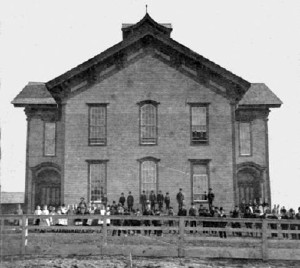
At present the township is generally well supplied with excellent
schools, Douglas and Saugatuck each having a fine graded school with a
combined accommodation for about 500 pupils. The following statistics in
regard to the public schools are given in an official report for the
year 1879 :
Number of districts 5
Enrollment 618
Average attendance 536
Value of property $17,700
Teachers' wages $2,708
There are also four fractional school districts in the township, with an aggregate of 40 school children.
The school directors for 1879 were H. B. Moore, W. A. Woodworth, James Perry, William Cumming, and L. Harrington.
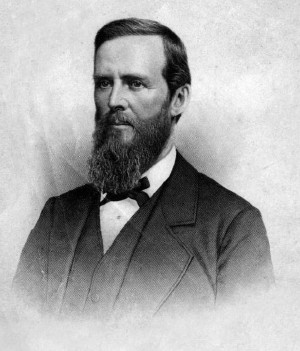
The life of Horace D. Moore
is the record of a successful business man whose conquests were the
result not so much of favorable circumstances as of sagacity combined
with untiring energy. He is the grandson of Rev. Robert M. Moore, who
was educated for the ministry in Edinburgh, Scotland, and whose diploma
reveals the year 1610 as the date of his graduation. He came to the
United States, and for many years filled the Presbyterian pulpit at
Pembroke, N.H. Horace D. was born at Ryegate, Caledonia Co., Vt., June
14, 1821, his parents having been Nathaniel and Dorothy Moore,
and his father's occupation that of a lumberman and farmer. His mother
was descended from the family of Banfords, of English extraction, who
were among the early settlers in Sanbornton, N.H., and closely
identified with its primitive history and the Indian warfare of early
days. The estate is still in the possession of the family. It is thus
determined that the name of Moore is one which bears with it the record
of a distinguished ancestry.
Horace D., whose life, though in a measure uneventful, was still one of
conspicuous success, began his career as a tanner, but soon relinquished
the pursuit as not congenial to his tastes. At the age of eighteen,
with his worldly effects wrapped in a small bundle, he crossed one of
the Green Mountain ridges and engaged at labor in a saw- and
shingle-mill. In 1841 he changed his location, though following the same
pursuit. His duties became more arduous, and admitted of little
leisure. Breakfast was eaten at half-past three o'clock, dinner at one,
and supper at nine o'clock. Mr. Moore, with untiring perseverance and
fortitude, endured this trying ordeal for four years, after which he
removed to Monroe, N.H. In 1846 he managed a milling interest at
Springfield, Mass., and in 1847, in connection with Gen. Roswell M. Richardson,
embarked in an extensive lumbering business, the firm having been
Richardson & Moore. In closing this successful enterprise in 1854,
their ledger revealed a profit to the partners of fifty thousand
dollars, and six thousand four hundred acres of pine-land paid for. Mr.
Moore then engaged in speculations in produce, which were not
successful. In 1855 he was an extensive purchaser of hemlock bark, which
enabled him to restore the losses suffered from former transactions,
and secure in addition a handsome profit.
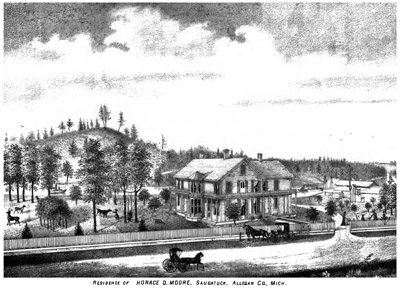
The year 1855 found him a traveler in the West, still actively engaged
in business pursuits. The former lumbering enterprise having proved
successful, Mr. Moore was in 1856 induced to invest capital in Allegan
County, and the following year began in Saugatuck an extensive lumber
and manufacturing interest. This he continued until the spring of 1875,
having cut more than two hundred million feet of timber and employed
many tugs and vessels as an accompaniment of the business. Upon
abandoning the latter enterprise, Mr. Moore devoted his time to farming
pursuits, having three improved farms to oversee, besides a large
quantity of land in Wisconsin and Illinois, and property of various
kinds elsewhere.
Mr. Moore is not less remarkable for his business capacity than for his
integrity. He has never been known to fail in the payment of all his
indebtedness, believing that honest debts should be liquidated upon the
basis of one hundred cents to the dollar. Neither at any time has a note
of his been known to go to protest. He is not an enthusiastic
politician, though a strong Republican, as he has been since the
organization of the party. He is a man of temperate habits, and
advocates temperance in all things, being in no sense an extremist.
Mr. Moore was married June 16, 1864, to Miss Tamer W. Phillips,
of Clyde, Allegan Co., Mich., who is a native of Cass County. Her
parents were former residents of New York State, and pioneers to Allegan
when their daughter was but eleven years of age, having first located
in Cass County. Mr. and Mrs. Moore have had four daughters, one of whom
was a victim to scarlet fever at an early age. This concise sketch
illustrates in a remarkable degree the success which is possible as the
result of integrity coupled with energy. Having began his career with
these as his only capital, Mr. Moore is now the most considerable
taxpayer in Allegan County.
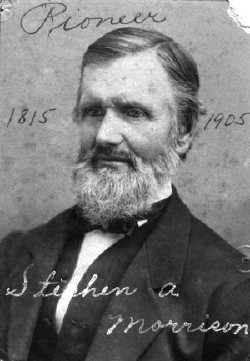
Among the venerable pioneers of Saugatuck the name of Morrison is conspicuous. Stephen A. Morrison,
the subject of this biography, was a settler as early as 1837, and
became immediately after his advent closely identified with the
interests of the township. He was the oldest son of Stephen Morrison,
who still survives and is, in his ninety-third year, yet vigorous and
active. Stephen A. was born in Danvers, Mass., May 18, 1815, and spent
most of his early life in labor, though at disconnected intervals
opportunities for study occurred.
At the age of eighteen he acquired the trade of a tanner, having served a
weary apprenticeship of four years, after which his steps were turned
towards Michigan. On his arrival in Saugatuck but four families
inhabited the township, which was destitute alike of highways and other
marks of civilization. The following year, in company with Samuel
Morrison, his brother, a tannery was started, which was ultimately
controlled by Stephen A., and has, to the present day, been profitably
and successfully conducted by him. In 1853 a disastrous fire entailed a
heavy loss, though the energy of Mr. Morrison very speedily enabled him
to recuperate.
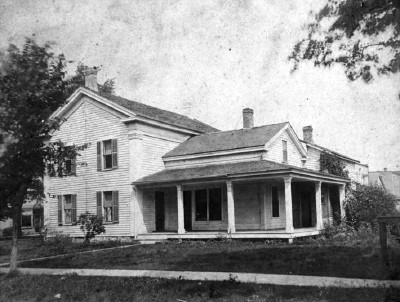
He was married in 1844 to Mary E., daughter of Samuel
and Sophia Peckham, whose birthplace was Vermont, and the date of her
birth Aug. 31, 1816. Of their five children, but two daughters are
living, Mrs. Leland [Jessie S. (Morrison) Leland], who resides with her parents, and Mrs. Francis [Julia (Morrison) Francis],
who is a resident of the village. The original home** has long since
been replaced by a more spacious and convenient one, a view of which is
seen upon an adjoining page. Mr. Morrison has held successively the
offices of county treasurer and supervisor, and has been for twenty
years postmaster of his village. His constituents have also tendered him
on more than one occasion the nomination for senator and representative
in the State Legislature.
**The original home was replaced in 1857 with the above pictured home
which was located on the northeast corner of Butler and Culver streets,
across from Morrison's store. It was later the Leland Lodge, which was
lost in 1979 to a fire.
According to SOME MORE RAISING THE ROOF,
by James Schmiechen "One of the oldest houses discovered in the recent
architectural survey is located at 334 Main Street, Saugatuck. It is the
home occupied by Stephen A. Morrison, who took over the Saugatuck
tannery in 1834. It was where he was living when he married the first
school teacher, Mary Elizabeth Peckham, until the couple built an
elegant home on the southeast corner of Butler and Culver Streets in
downtown Saugatuck."
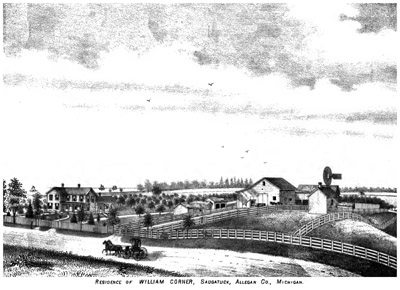
William Corner
was the only child of Hugh and Sarah Corner, subjects of the British
Crown, and was born in the county of Devon, England, Dec. 14, 1819.
William, until he reached the age of manhood, remained at home, after
which he married Miss Mary Ann Goodeve, the date of their union having been Feb. 10, 1841. Two children were theirs, Eliza J.,
born in Genesee Co., N. Y., Feb. 14, 1842; and Khoda R., whose birth
occurred Feb. 26, 1845, and her death in September of the following
year. Soon after their marriage Mr. and Mrs. Corner sailed for America,
and on their arrival located at once in Genesee Co., N.Y., where he
followed the trade of a cooper. After later changes in location he
determined to become a pioneer, and chose Michigan as a residence,
having removed to the State in 1852. He purchased one hundred acres in
the township of Saugatuck, upon which he still resides. Having in 1862
been afflicted by the death of his wife, after a lingering illness, Mr.
Corner married, in 1864, Miss Lorain Bathrick,
who was born in Wyoming Co., N.Y. in 1834. He has devoted much labor to
the cultivation of fruit, and made peaches a specialty. Six thousand
bearing trees now adorn his farm, which is one of the most attractive in
the township.
Mr. Corner is not an active political partisan. He votes the Republican
ticket, and has held minor offices, but is not ambitious for
distinctions of an official character. He is a man of strong religious
instincts, is active as a church member, superintendent of the
Sabbath-school, and directs the church music, for which his musical
abilities admirably fit him.
Related references
1834c Saugatuck / Douglas Federal Land Grants
History of Allegan and Barry counties, Michigan 1880
History of Allegan County, Michigan 1907
Pioneer Collections, Volume 3, 1880
Saugatuck - Douglas Biographies
Findagrave.com Douglas Cemetery and Saugatuck's Riverside Cemetery

SAUGATUCK-DOUGLAS HISTORICAL SOCIETY | BOX 617 | DOUGLAS, MI 49406 | 269-857-5751 |
http://www.sdhistoricalsociety.org